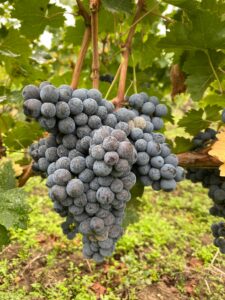
Bordeaux 2025: small volume, big ambition
Bordeaux, Vendanges 2025: precocity, small volumes but strong qualitative potential

The 2025 season in Bordeaux was marked by notable precocity. After a humid spring, the vines entered a sustained phase of hydric stress from the end of May onwards. Summer was warm, punctuated by localised showers that did little to compensate for the structural water deficit, even though early September rainfall brought genuine relief, particularly for cabernet franc which was able to complete its maturation. In certain areas, the precocity was exceptional, with white harvests beginning in the first half of August, an unprecedented occurrence in living memory for these sectors. Harvesting therefore began very early, reflecting accelerated ripening and a complex growing season in the current climatic context.
Within this framework, caution remains essential when interpreting hydric stress. The vine benefits from a degree of stress and is a rustic, Mediterranean-origin plant that with stands adversity better than is often assumed. The year was also marked by three very hot periods, including mid-August, which weakened the skins of already well-ve raised berries, though without genuinely hot nights, which remained relatively cool and helped limit the intensity of hydric stress. Added to this was the notable absence of disease: virtually no significant pressure disrupted the harvest operations, enabling serene working conditions and grapes of excellent sanitary state.
From a quantitative standpoint, production in the Gironde is estimated at around 3.7 million hectolitres, a level similar to 2024 but roughly 15 percent below the five-year average. This contraction forms part of a broader structural adjustment of the vineyard, with nearly 8,000 hectares officially uprooted in recent years. To this must be added a widely shared observation across the region: yields are low, despite a promising start to the season, with an average often situated around 30 hectolitres per hectare, the result of fewer clusters, small berries and pronounced dehydration.
Volumes in whites are historically low. Across the Bordeaux vineyard, production is unlikely to exceed around 250,000 to 270,000 hectolitres of dry white, representing a drop of roughly one quarter relative to the recent average. Hydric stress reduced the juice content per berry, particularly in Entre deux Mers and on certain gravelly rises. Nevertheless, dry whites exhibit preserved acidities, appealing tension and clear aromatics, even if some terroirs experienced obvious ripening blockages.
 As for the reds, concentration is marked. The berries are smalland few, the colour deep and intense, the aromatics fresh and precise, and the tannins fine and well-defined. Merlot generally suffered more from heat episodes and lack of water, while the cabernets demonstrated greater resilience. The alcohol–acidity balance is good, the wines show attractive freshness and considerable potential. However, some terroirs clearly suffered, with blocked ripening, heterogeneous maturation within the same cluster and episodes of defoliation.
As for the reds, concentration is marked. The berries are smalland few, the colour deep and intense, the aromatics fresh and precise, and the tannins fine and well-defined. Merlot generally suffered more from heat episodes and lack of water, while the cabernets demonstrated greater resilience. The alcohol–acidity balance is good, the wines show attractive freshness and considerable potential. However, some terroirs clearly suffered, with blocked ripening, heterogeneous maturation within the same cluster and episodes of defoliation.
In this respect, a reminder helps nuance collective perceptions of the vintage: in 2003, merlot produced very fine winesdespite the drought, even though concerns about hydric stress heavily influenced many tasters’ expectations. And as Michel notes, in 1947 there were almost no leaves left, which did not prevent the vintage from becoming mythical in Pomerol and neighbouring Saint Émilion. In 2025, the key remains the balance between alcohol, acidity and tannins, in sufficient quantity and density to guarantee harmony and power.
Significant heterogeneity across the terroirs
Geographical contrasts are pronounced. On the left bank, in the Médoc and Haut Médoc, picking was swift, producing wines with firm tannic structure and dense texture. On the right bank, the Pomerol plateau was exposed to summer drought and produced small berries, although it would bein accurate to claim that the vines there suffered excessively. Clay–limestone terroirs also experienced foliar over heating and produced small berries. Concentration is remarkable, volumes remain low, but balance is present and calls for prudence in drawing firm conclusions. In the best-ventilated and deepest terroirs of Saint Émilion, ripening is homogeneous and the balances highly promising. The clays performed well, while the limestones sometimes struggled but benefited from underground water sources. By contrast, sandy zones experienced the drought with difficulty.
In Graves and Pessac Léognan, both whites and reds present concentrated matter and a satisfactory sanitary state. Quality depends largely on the precision of the extractions and careful management of macerations.
In Sauternes and Barsac, volumes are modest but conditions have been particularly favourable. Thanks to late-August rainfall, botrytis established itself very early, in an unusually precocious dynamic. This early onset fostered remarkable aromatic intensity, great freshness and an elegantly poised style. The first juices suggest sweet wines of very high potential, with clear definition and overall complexity driven by this botrytic dynamic.
Overall, yields lie between 25 and, at best, 35 hectolitres perhectare. The diversity of the vine’s responses to hydric constraints confirms the need for a fine-grained terroir-base dreading, and the decisive role of vineyard management, harvest timing and extraction choices.
In conclusion, 2025 is shaping up to be a low-volume but highly qualitative vintage in Bordeaux. Hydric constraints, extreme precocity in certain sectors, low yields and the absence of disease have shaped a concentrated, healthy and promising harvest. The balance between alcohol, acidity and tannins appears with enough density to ensure both harmony and power, while in Sauternes and Barsac the precocity of botrytis points towards sweet wines of high calibre. An atypical vintage, but one carrying clear potential.
